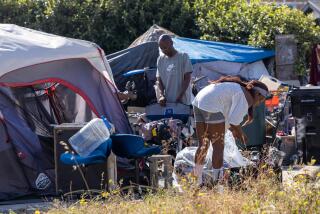L.A. County has its most accurate count yet of its homeless population
It was a balmy night in January when the team of four young professionals struck out from South El Monte City Hall to walk the dark streets of unfamiliar neighborhoods.
Their mission was to canvass three census tracts in the mid-San Gabriel Valley in search of the homeless.
The first was a predominantly Latino tract of former horse properties now yielding to Asian mansions.
Dogs, chickens and even the scent of a holdover horse or two were evident. But the homeless were not until, at the intersection of a thoroughfare, the canvassers came upon an old white van.
They stopped, waited, listened, until the faintest sound of life emanated. They made a hash mark on a form indicating one van. Then a few streets away they found an occupied car and marked it too.
Their next tract took them to an underpass of the 605 Freeway beside an open field, a strange and slightly frightening place at night. They clambered down the concrete embankment into the cavern under the freeway. They heard a cough and saw the shadow of a lean-to: a shelter.
The four were volunteers on the first night of the 2015 homeless count conducted by the Los Angeles Homeless Services Authority. The joint city-county agency formed to manage homeless services had promised to dispatch 5,500 volunteers to do what had never been done before — visually survey more than 80% of the county to tally the homeless.
The survey results — released for the first time this year with the actual counts in each census tract — show that the homeless are almost everywhere in L.A. County.
Not surprisingly, the highest concentration fell in the five downtown census tracts, including skid row. Venice came next, followed by Santa Monica and Hollywood and smaller clusters in Lancaster, South Los Angeles and Pomona.
Vehicles followed a different pattern, appearing prominently in South Los Angeles, the Antelope Valley and Westchester.
Encampments of tents and make-shift shelters showed up around the 110 Freeway both north and south of downtown and also along the South Bay portion of the 405.
No homeless were sighted in about 300 tracts, small areas of 4,000 to 6,000 people. But 165 tracts had 10 or more vehicles; 74 tracts had 10 or more tents or shelters.
Previous surveys going back a quarter century had failed to capture the diffused and hidden homeless.
In one of those efforts, announced with great fanfare, the Census Bureau attempted to enumerate the homeless for the 1990 Census.
But that historic “count” hardly got beyond the streets of skid row. The enumerators never showed up in places such as Glendale’s Brand Boulevard where every storefront was a sleeping den for a homeless person.
In response to criticism from homeless advocates who called the count drastically low, the Census Bureau spent hundreds of thousands of dollars on homeless “ambassadors” leading up to the 2000 Census in hopes of doing a more credible count. But, concluding it couldn’t overcome the obstacles to counting the homeless, the bureau abruptly dropped the plan, provoking another outcry.
In 2005, LAHSA launched its homeless count with a force of volunteers who combed over about 510 census tracts, barely a quarter of the 1,887 in its territory (excluding Glendale, Pasadena and Long Beach, which conduct their own counts).
To derive a total, the agency contracted with a research laboratory to statistically extrapolate for the three-quarters of uncounted tracts.
Every two years since then, LAHSA has expanded its reach. In 2013 volunteers counted 1,371 tracts. That allowed a more accurate estimate of the total homeless population. But cartographically speaking, it still made for a Swiss-cheese picture.
With 1,684 tracts on its itinerary this year, LAHSA may have hit the sweet spot, enough to make a nearly seamless map.
INTERACTIVE: Where are L.A. County’s homeless?
And the volunteers did come through.
Over two nights and a day, they assembled at more than 100 deployment sites in churches, city buildings, social service centers and sober-living homes from San Pedro to Lancaster. College roommates, retirees, men in their workday suits, mothers and daughters, fathers and sons, whole families showed up all yearning to do something for the homeless, even if that was nothing more than counting.
Forming impromptu teams, clipboards in hand, they ventured into the night. Hours later they trickled back, some flush with accomplishment. Others showed pangs of defeat — they had found no homeless, but they had done their job.
After tabulating the tract counts, adjusting for vehicles and encampments, extrapolating numbers for the uncounted tracts and adding in shelters and counts from the three other cities, LAHSA came up with an L.A. County homeless population of 44,359, a number that despite its apparent precision has a margin of error of plus or minus 760.
More to Read
Sign up for Essential California
The most important California stories and recommendations in your inbox every morning.
You may occasionally receive promotional content from the Los Angeles Times.











